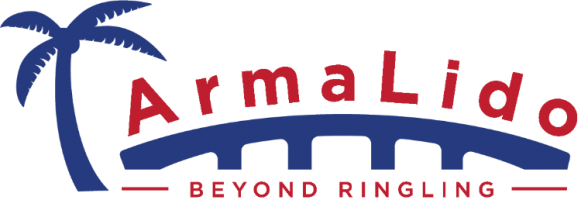St. Armands Key
Welcome to St. Armands Key
An island shopping center removed from the bustle of the mainland by two bridges over magnificent
Sarasota Bay. Unique in concept, history, and beauty, St. Armands provides an unforgettable
experience for visitors from all over the world.
Renowned as a market place with a continental flavor, it is a charming and graceful synthesis of past and present. Lush tropical plantings, courtyards and patios, antique statuary, and contemporary architectural design skillfully contribute to an international atmosphere of friendly warmth, enduring elegance, and timeless style. Relax in the restaurants, explore the shops – from trinkets to treasures, gourmet snacks to candlelight feasts, you’ll find it all on St. Armands Circle.
Today, more than 130 stores on St. Armands Circle pamper customers from all areas of the United States and many foreign countries, but in the early 1900s, the key was just a mangrove island too far from the small fishing village of Sarasota to attract much attention.
In 1893, Charles St. Amand, A Frenchman and first resident of the island, purchased for $21.71 three tracts of land totaling 131.89 acres. He homesteaded the land, fishing in the waters of the Gulf and Bay, and, along with other early pioneers, raised produce which he brought by boat to the market at City Pier in Sarasota. In later land deeds, his name was misspelled “St. Armand” and this spelling has persisted to the present day.
Visionary circus magnate John Ringling purchased the St. Armands Key property in 1917 and planned a development that included residential lots and a shopping center laid out in a circle. As no bridge to the key had yet been built, Ringling engaged an old paddle-wheel steamboat, the “Success”, to serve as a workboat. His crews labored at dredging canals, building seawalls, and installing sidewalks and streets lined with rose-colored curbs. In 1925, work began on a causeway to join St. Armands Key to the mainland. Circus elephants were used to haul the huge timbers from which the bridge and causeway were built.
One year later, amid much pomp and ceremony, both the John Ringling Causeway and Ringling Estates development opened to the public, with John Ringling himself leading a parade across the causeway and his Circus Band playing from a bandstand in the center of the Circle. Every hour there was free bus service from downtown to St. Armands for prospective buyers and sightseers.
Property sales that the first day was estimated to exceed one million dollars but the boom ended quickly. As the nationwide depression worsened, land sales in Florida and on St. Armands stopped completely. In 1928, the City of Sarasota accepted as a gift the causeway which Ringling himself could no longer afford to maintain. Gradually, the wooden causeway began to rot, the Circle bandstand sagged, and the native vegetation covered the carefully planned streets and sidewalks.
For nearly 20 years, St. Armands slept …. children played ball where the bandstand once stood and only curious tourists ventured out to view the once-famous key. During the 1940s, several courageous investors opened restaurants and a service station on the Circle but not until 1953 did business once again resume on St. Armands. By 1955 a number of stores had opened.
John Ringling’s influence is still evident today in the planning and design of streets radiating from the circle at the island’s hub and the Italian statuary from his personal collection strategically placed around the key. This shopping circle looks very much as Ringling originally envisioned it, with the palm-lined medians, park-like setting, and tropical plantings he intended. Gone are the pioneer farms, vacant lots, and the bandshell featuring Sunday afternoon concerts.
Pages
- Home
- ArmaLido Activities Calendar
- St. Armands Key
- Armalido Ladies Social Group
- Ladies Group Introduction
- Photos
- ArmaLido Community Christmas Choir
- Choir Group Introduction
- Choir Photos
- Neighborhood Fishing Friends
- New Pass Fishing 3.15.24
- Photos
- Southeast Quadrant Group
- SEQ Introduction
- Photos of SEQ Neighbors
- SEQ Forum
- ArmaLido Veterans Group
- Veteran's Group Introduction
- Veteran's Group Photos
- Veteran's Forum
- Veteran's Group Events
- ArmaLido Wildlife Group
- Wildlife Group Introduction
- Wildlife Group Photos
- Wildlife Group Forum
- Contact the admin


